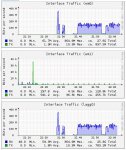FreeNAS-8.0.2-RELEASE-amd64 (8288)
Motherboard: Intel S3000AH
http://download.intel.com/support/motherboards/server/s3000ah/sb/d72579003_s3000ah_tps_1_4.pdf
--From Manual linked above--
NIC 1 is an Intel® 82573E gigabit Ethernet controller resourced with an x1 PCI Express* interface from the Intel® ICH7R (PCI Segment C).
NIC 2 is an Intel® 82541PI Gigabit Ethernet Controller is resourced with a 32-bit/33 MHz PCI Segment from the Intel® ICH7R (PCI Segment A) on the S3000AHLX and S3000AH SKU only.
--from dmesg--
em0: <Intel(R) PRO/1000 Network Connection 7.1.9> port 0x2000-0x201f mem 0x88180000-0x8819ffff,0x88100000-0x8817ffff irq 17 at device 0.0 on pci3
em1: <Intel(R) PRO/1000 Legacy Network Connection 1.0.3> port 0x1100-0x113f mem 0x88020000-0x8803ffff,0x88000000-0x8801ffff irq 17 at device 5.0 on pci4
#ifconfig
em0: flags=8843<UP,BROADCAST,RUNNING,SIMPLEX,MULTICAST> metric 0 mtu 1500
options=219b<RXCSUM,TXCSUM,VLAN_MTU,VLAN_HWTAGGING,VLAN_HWCSUM,TSO4,WOL_MAGIC>
ether 00:15:17:7c:42:55
media: Ethernet autoselect (1000baseT <full-duplex>)
status: active
em1: flags=8843<UP,BROADCAST,RUNNING,SIMPLEX,MULTICAST> metric 0 mtu 1500
options=209b<RXCSUM,TXCSUM,VLAN_MTU,VLAN_HWTAGGING,VLAN_HWCSUM,WOL_MAGIC>
ether 00:15:17:7c:42:55
media: Ethernet autoselect (1000baseT <full-duplex>)
status: active
lo0: flags=8049<UP,LOOPBACK,RUNNING,MULTICAST> metric 0 mtu 16384
options=3<RXCSUM,TXCSUM>
inet6 fe80::1%lo0 prefixlen 64 scopeid 0x3
inet6 ::1 prefixlen 128
inet 127.0.0.1 netmask 0xff000000
nd6 options=3<PERFORMNUD,ACCEPT_RTADV>
lagg0: flags=8843<UP,BROADCAST,RUNNING,SIMPLEX,MULTICAST> metric 0 mtu 1500
options=209b<RXCSUM,TXCSUM,VLAN_MTU,VLAN_HWTAGGING,VLAN_HWCSUM,WOL_MAGIC>
ether 00:15:17:7c:42:55
inet 192.168.1.216 netmask 0xffffff00 broadcast 192.168.1.255
media: Ethernet autoselect
status: active
laggproto lacp
laggport: em1 flags=1c<ACTIVE,COLLECTING,DISTRIBUTING>
laggport: em0 flags=1c<ACTIVE,COLLECTING,DISTRIBUTING>
---------
Switch is an HP 2848 J4904A
http://h10010.www1.hp.com/wwpc/ca/e...6298-12136298-12136316-12136322-29584733.html
--Config--
interface 45
name "FreeNas EM0"
exit
interface 46
name "FreeNas EM1"
exit
switch# show trunk
Load Balancing
Port | Name Type | Group Type
---- + -------------------------------- --------- + ----- -----
45 | FreeNas EM0 100/1000T | Dyn1 LACP
46 | FreeNas EM1 100/1000T | Dyn1 LACP
switch# show lacp
LACP
PORT LACP TRUNK PORT LACP LACP
NUMB ENABLED GROUP STATUS PARTNER STATUS
---- ------- ------- ------- ------- -------
45 Passive Dyn1 Up Yes Success
46 Passive Dyn1 Up Yes Success
---------
When I setup FreeNas I chose LACP as the method for the link aggregation. On the switch the ports are set for LACP Passive.
Start transferring files from 1 computer on the same subnet and you see the spike about the middle of the graphs all on EM0, as I would expect it to be.
Then there is a lull in the graphs as I ready 3 computers to transfer data to the FreeNas box. My theory was PC 1 would start on EM0, PC 2 would start on EM1 and PC 3 back to EM0. Start transfer on PC1 then PC2 then PC3 and wait a while for the graphs to show decent amount of data. Watching the switch with link activity I see only one port is active during the transfers to FreeNas. Pull the graphs up after a period of time you can see that all traffic is on one interface and half of what a single PC transferring to the FreeNas could pull off.

My question are:
What am I doing wrong in this config that I am only getting traffic on one interface?
Or am I off base thinking traffic from multiple sources should be split across both interfaces?
Why do I get half the network speed on EM0 when I have more than one source transmitting?
Motherboard: Intel S3000AH
http://download.intel.com/support/motherboards/server/s3000ah/sb/d72579003_s3000ah_tps_1_4.pdf
--From Manual linked above--
NIC 1 is an Intel® 82573E gigabit Ethernet controller resourced with an x1 PCI Express* interface from the Intel® ICH7R (PCI Segment C).
NIC 2 is an Intel® 82541PI Gigabit Ethernet Controller is resourced with a 32-bit/33 MHz PCI Segment from the Intel® ICH7R (PCI Segment A) on the S3000AHLX and S3000AH SKU only.
--from dmesg--
em0: <Intel(R) PRO/1000 Network Connection 7.1.9> port 0x2000-0x201f mem 0x88180000-0x8819ffff,0x88100000-0x8817ffff irq 17 at device 0.0 on pci3
em1: <Intel(R) PRO/1000 Legacy Network Connection 1.0.3> port 0x1100-0x113f mem 0x88020000-0x8803ffff,0x88000000-0x8801ffff irq 17 at device 5.0 on pci4
#ifconfig
em0: flags=8843<UP,BROADCAST,RUNNING,SIMPLEX,MULTICAST> metric 0 mtu 1500
options=219b<RXCSUM,TXCSUM,VLAN_MTU,VLAN_HWTAGGING,VLAN_HWCSUM,TSO4,WOL_MAGIC>
ether 00:15:17:7c:42:55
media: Ethernet autoselect (1000baseT <full-duplex>)
status: active
em1: flags=8843<UP,BROADCAST,RUNNING,SIMPLEX,MULTICAST> metric 0 mtu 1500
options=209b<RXCSUM,TXCSUM,VLAN_MTU,VLAN_HWTAGGING,VLAN_HWCSUM,WOL_MAGIC>
ether 00:15:17:7c:42:55
media: Ethernet autoselect (1000baseT <full-duplex>)
status: active
lo0: flags=8049<UP,LOOPBACK,RUNNING,MULTICAST> metric 0 mtu 16384
options=3<RXCSUM,TXCSUM>
inet6 fe80::1%lo0 prefixlen 64 scopeid 0x3
inet6 ::1 prefixlen 128
inet 127.0.0.1 netmask 0xff000000
nd6 options=3<PERFORMNUD,ACCEPT_RTADV>
lagg0: flags=8843<UP,BROADCAST,RUNNING,SIMPLEX,MULTICAST> metric 0 mtu 1500
options=209b<RXCSUM,TXCSUM,VLAN_MTU,VLAN_HWTAGGING,VLAN_HWCSUM,WOL_MAGIC>
ether 00:15:17:7c:42:55
inet 192.168.1.216 netmask 0xffffff00 broadcast 192.168.1.255
media: Ethernet autoselect
status: active
laggproto lacp
laggport: em1 flags=1c<ACTIVE,COLLECTING,DISTRIBUTING>
laggport: em0 flags=1c<ACTIVE,COLLECTING,DISTRIBUTING>
---------
Switch is an HP 2848 J4904A
http://h10010.www1.hp.com/wwpc/ca/e...6298-12136298-12136316-12136322-29584733.html
--Config--
interface 45
name "FreeNas EM0"
exit
interface 46
name "FreeNas EM1"
exit
switch# show trunk
Load Balancing
Port | Name Type | Group Type
---- + -------------------------------- --------- + ----- -----
45 | FreeNas EM0 100/1000T | Dyn1 LACP
46 | FreeNas EM1 100/1000T | Dyn1 LACP
switch# show lacp
LACP
PORT LACP TRUNK PORT LACP LACP
NUMB ENABLED GROUP STATUS PARTNER STATUS
---- ------- ------- ------- ------- -------
45 Passive Dyn1 Up Yes Success
46 Passive Dyn1 Up Yes Success
---------
When I setup FreeNas I chose LACP as the method for the link aggregation. On the switch the ports are set for LACP Passive.
Start transferring files from 1 computer on the same subnet and you see the spike about the middle of the graphs all on EM0, as I would expect it to be.
Then there is a lull in the graphs as I ready 3 computers to transfer data to the FreeNas box. My theory was PC 1 would start on EM0, PC 2 would start on EM1 and PC 3 back to EM0. Start transfer on PC1 then PC2 then PC3 and wait a while for the graphs to show decent amount of data. Watching the switch with link activity I see only one port is active during the transfers to FreeNas. Pull the graphs up after a period of time you can see that all traffic is on one interface and half of what a single PC transferring to the FreeNas could pull off.

My question are:
What am I doing wrong in this config that I am only getting traffic on one interface?
Or am I off base thinking traffic from multiple sources should be split across both interfaces?
Why do I get half the network speed on EM0 when I have more than one source transmitting?
